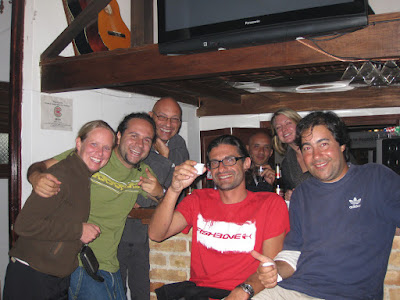Another overnight bus ride (we're actually getting used to them) from Salento to Armenia to Bogota got us into Bogota a lot earlier than we anticipated. We arrived back at our hostel, Destino Nomada, around 4:00 AM. Luckily our room was vacant so we were able to get in early and catch a little sleep. After the seclusion of the coffee region, Bogota was a bit of a culture shock, but it allowed us to catch up on emails, Skype, photo uploading and blog entries. And, like our first stay at Destino Nomada, we played some poker and drank some Aguardiente, which made for a rough travel day to Lima on Thanksgiving.
It was nice to spend a couple of days in Bogota where we caught up with friends we had made on our first stay and met a bunch new folks as well. However, if I never see another shot of Aguardiente again it will be too soon!
 |
|
The flight to Lima was relatively painless (even with Aguardiente hangovers), but we only had a few short hours in Lima before our flight to Cusco in the morning. We had a traditional rice and chicken Peruvian meal that served ably as a substitute for Thanksgiving dinner, but made us all-too-aware of the good friends and family we were missing back home.
Once we arrived in Cusco, we dropped our bags and went to have a look around. Cusco reminds us a lot of Cuenca, EC, our first real stop on this trip. Cusco is smaller and has more tourism due to its proximity to Machu Picchu, however. We see far more tourists here than in any other stop on our trip so far, but it doesn't feel obnoxious.
We found a great little pub that has a balcony overlooking the main square, Plaza de Armas, and had a few drinks. This was the first spot we've found to have a good beer and I took advantage enjoying a Samuel Smith stout and a Samuel Smith Taddy Porter. Leslie had a go at the Peruvian national drink (perhaps unofficially) pisco. And then our camera battery died.
We spent much of the day today renting gear, checking routes and buying food supplies for our trek to Machu Picchu. Although Leslie did take some time out to hold a lamb. :P
We leave tomorrow, Sunday, for what is supposed to be a grueling seven day hike. We are taking a more scenic route that has fewer tourists and is far less regulated than the Inca Trail, the most popular tourist route to the ruins. We'll be out off touch for the next week, but plan to take a few days to recover back here in Cusco after the trek. So we will undoubtedly have time to update the blog then, so stayed tuned!